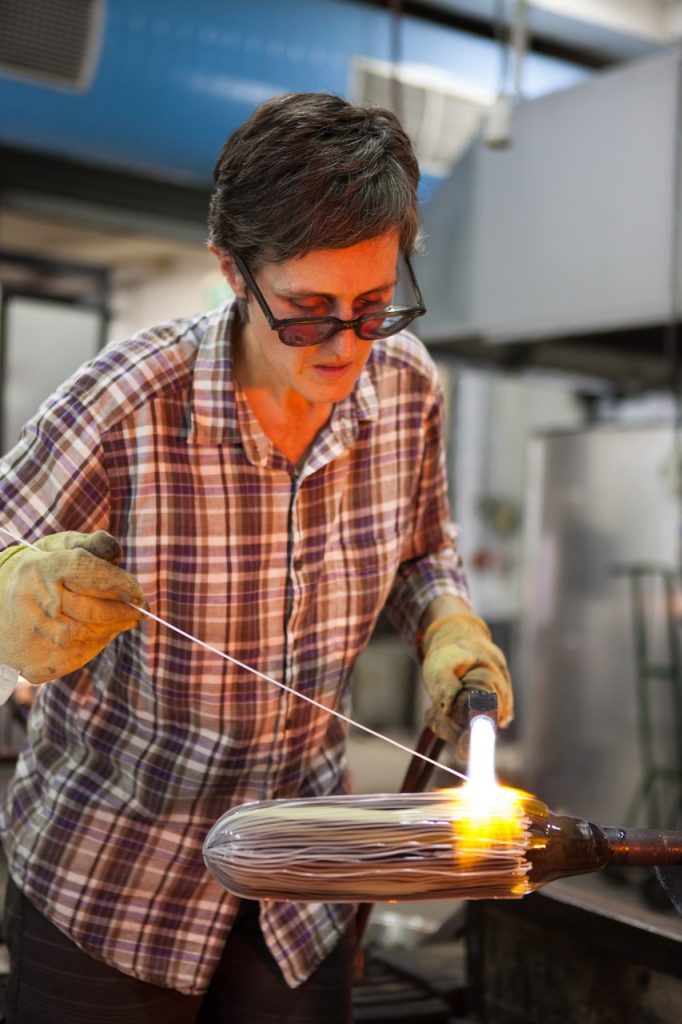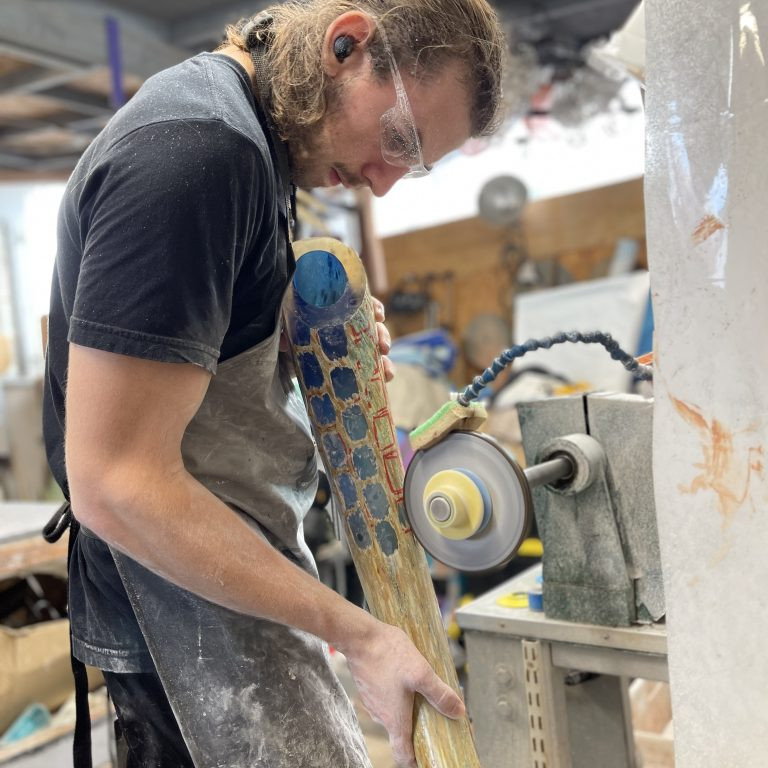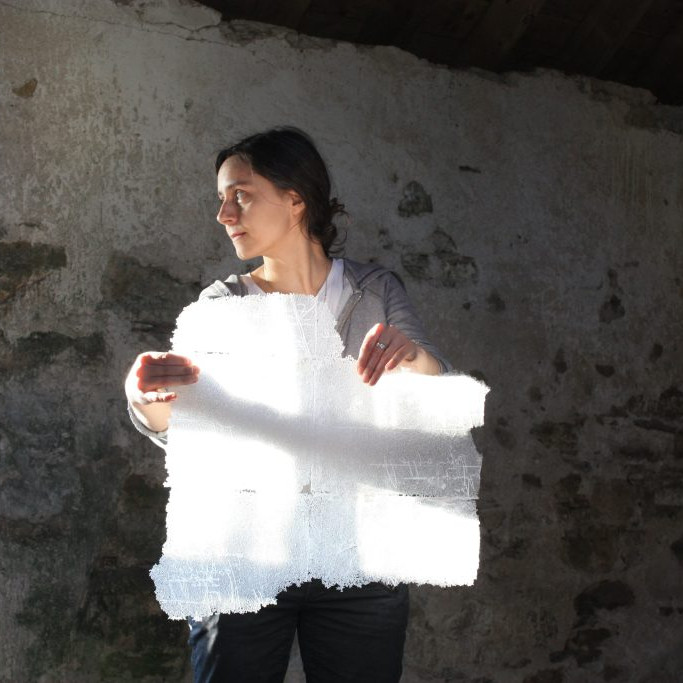Clare Belfrage Glass Artist
Can you discuss your use of line and its relationship with nature?
I have worked with the repetition of an element for many years now and most often using line to create pattern and rhythm. I think initially I used line to reference the grassy spines of the Yakka or Xanthorrea plant as well as using line to create glass drawings. I see the repetition of line in many parts of the natural world whether it is in the specific patterns of plants, rocks, shells, or as an expression of current or movement as experienced in water, sand and clouds. Working with line has been the way I’ve expressed something of the complexity of life that I have observed around me in the natural world. I am really interested in the detail in nature and ways of marking out the living of a life, the passing of time.

Awash in Grey, 2014, blown glass with cane drawing, sanded, 52 x 45 x 7cm, Photo by Grant Hancock
How are the threads of glass attached and can they be felt in the final work?
The threads of glass, often called stringers, are fused onto the surface of the glass during the hot process. I prepare the stringers by stretching out a gather of glass with a coloured core to a very fine diameter. Then I use a small torch to heat the stringer at the point of contact to my glass piece to attach it while manoeuvring it to create the pattern.
For different pieces I draw at varying stages of the process and this has an impact on the tactile quality of the line. When I draw early in the process and then gather more glass over the pattern work, the surface will be completely smooth. When I draw later in the process then the line work sits in relief and can be felt.
How have Canberra and Adelaide combined in your art life?
Being part of community has always been really important to me. In fact I’m sure its one of the aspects that really drew me to glass. From the time I finished my studies I felt I was able to jump into the current of Studio glass here in Australia and overseas, and there are many ways I have benefitted from this community. Adelaide and Canberra have been particularly important to me. There are many connections between these two cities and the incredibly vibrant glass communities they house.
I have worked in and around the JamFactory Glass studio in Adelaide since the early nineties and it is still where I do my glassblowing – and also participate in monthly clean-ups and studio meetings. In 1997 I was part of a group that started blue pony, also in Adelaide, a shared studio that ran for 15 years. This was a formative time for me as an artist and again a really important period of community support and growth.
I have also felt a strong connection to Canberra since the early nineties and have enjoyed great conferences, exhibitions and other events there. From 2009 – 2013 I had the privilege of being the Creative Director of Canberra Glassworks where I was able to engage with the Canberra based community and be creative at a whole other level to my artistic practice. I worked with a strong team and we were able to present great programs and events across all areas of glass making: workshops, exhibitions, residencies, collaborations, parties and festivals with the dual engagement of artists and the general public.
I am based again in Adelaide but enjoy all of the connections between the two cities and in fact my solo exhibition, A Measure of Time, a JamFactory touring exhibition is currently on show at the Canberra Glassworks gallery.
How important has the Tom Malone Glass Prize been to your career?
Winning the Tom Malone Prize in 2005 was an absolute thrill. It is an incredible validation of your work as an artist. The prize money is always very useful and being in the public collection of the Art Gallery of Western Australia is of course such an honour.

Tom Malone Prize Winner 2011, 2010, blown glass with cane drawing, 36 x 50 x 9cm, Photo by Rob Little
Winning the prize a second time in 2011 was probably even more of a surprise! The work was very different from the first piece which was great, and the judges, from their comments really acknowledged the development in my work which again was very affirming.
Take two pieces that have gone into overseas collections. (What and why these have been such highlights to you?)

Leaf Circuitry pair, (in the Corning Museum Collection USA) Tallest 42cm, Photo by Rob Little
The Corning Museum of Glass acquired two Leaf Circuitry pieces. These were some of the hardest pieces I have made in terms of the drawn pattern. The pattern comes from a type of eucalyptus leaf that I found particularly unusual. I was excited by it because of the way the rhythm was established and then interrupted by tangental lines. I was very glad that these pieces went to Corning.
With over 25 years, experience in glass art, what have been some of the major changes you have seen in the glass world?
I think the digital age has meant that there is so much more information that students can access. You can watch Youtube videos on almost anything! I think this has really increased the technical knowledge and skill levels in glass.
I feel like I have seen the popularity of glass rise and then fall again both for makers and in terms of the market. I think these things happen in cycles and that’s ok especially if you keep a long view.
What I really feel excited about is that artists are still being highly innovative with the material and that is ensuring a vitality within contemporary practice.

Collection of vessels at the David Roche Foundation Museum, Photo by Pippy Mount
Many of your works are all about form and shape. Discuss this aspect of your work.
A long time ago I moved away from the idea of ‘decorating a form’ and focused on the form and pattern being integral to each other. The form or shape always comes from the core idea but without heading down a path of being too literal. I like to think about what is the essence of an object or what are the core elements. This has resulted in many asymmetrical and flattened forms to carry the pattern work of my glass drawings.

Close Impression, teal and white, blown glass with cane drawing, sanded and pumice polished, 35 x 32 x 11cm, Photo by Pippy Mount.
Size, do you have a limit to the size of the work you do?
As my work is all made from the process of blowing glass there are definitely limits to the scale. In the last 12 months though, I have taken another step up in scale. I have a great team I can work with and we have been able to go pretty big for blown glass. This has enabled me to explore the feeling of a monolith and also the relationship between pattern and form on a larger scale. I guess the largest pieces are approximately 12 kilos and close to 70cm tall.

Untitled #6, Blown glass with cane drawing, 41 x 31 x 8cm, Photo by Grant Hancock
Pistachio and Blue collection is a group of pieces. Do you make many collects or mainly single pieces?
Over the last 20 years I have presented work most often as singles, but I have definitely made pairs and collections. Sometimes it is how the pieces speak to each other in a collection that becomes one of the most interesting aspects of the work. Most recently I have presented some collections made from pieces from different series. This has been particularly exciting for me.

Quiet Shifting, Purple and Gold Blown glass with cane drawing, sanded and pumice polished 64 x 40 x 20cm Photo: Pippy Mount
Comment on the title, SALA and your personal thoughts on this?
SALA – South Australian Living Artists Festival – is a brilliant, inclusive and huge visual arts festival held every August across South Australia. SALA invites all artists at all levels to participate. It is the biggest visual arts festival in Australia. In 2018 I was the ‘Feature Artist’ of the Festival. This meant that a monograph on my career and practice, titled, Rhythms of Necessity, written by Kay Lawrence and Sera Waters was published and launched. I also had a major solo exhibition, A Measure of Time, as JamFactory’s 2018 Icon, and national tour of the exhibition to eleven venues over three years. I gave a number of public presentations and demonstrations. This was an immense honour and a great opportunity to highlight glass making practice in South Australia and beyond.
How important is professional development to your current work?
I have always enjoyed being active in projects outside of my direct practice. I like the intellectual stimulation and contact with other interesting people. I’ve been involved in developing and hosting conferences and I always attend our Ausglass conferences. I am currently on the Board of Guildhouse, a not-for-profit organization that supports South Australian visual artists, craftspeople and designers to build and maintain sustainable careers. I’m not sure that these experiences directly influence my art work but they are nonetheless very important to me.
Take a resent piece and discuss…
A MEASURE OF TIME from Randy Larcombe on Vimeo.
This was made by Randy Larcombe. It is also called A Measure of Time.
How does your personal environment influence your work particularly colour?
I definitely look to the natural world for my colour sensibility. I mostly look at Australian plants but I am not a purist. I enjoy gardening and I have made a pretty nice front garden of native plants that has really focused on different textures. When I can I go bush walking and camping and I draw inspiration from these experiences.
Clare Belfrage
Adelaide, Australia
insta: clare_belfrage
Deborah Blakeley, Melbourne, Australia
Interview by Deborah Blakeley, December 2019
Think a colleague or friend could benefit from this interview?
Knowledge is one of the biggest assets in any business. So why not forward this on to your friends and colleagues so they too can start taking advantage of the insightful information the artist has given?
Other artists you may be interested in:






